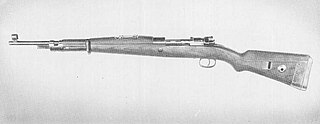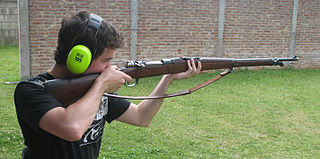
Mauser, originally Königlich Württembergische Gewehrfabrik , was a German arms manufacturer. Their line of bolt-action rifles and semi-automatic pistols has been produced since the 1870s for the German armed forces. In the late 19th and early 20th centuries, Mauser designs were also exported and licensed to many countries which adopted them as military and civilian sporting firearms. The Gewehr 98 in particular was widely adopted and copied, and is the foundation of many of today's sporting bolt-action rifles.

The M1903 Springfield, officially the United States Rifle, Caliber .30-06, Model 1903, is an American five-round magazine-fed, bolt-action service repeating rifle, used primarily during the first half of the 20th century.

The Mannlicher M1895 is a straight pull bolt-action rifle, designed by Ferdinand Ritter von Mannlicher that used a refined version of his revolutionary straight-pull action bolt, much like the Mannlicher M1890 carbine. It was nicknamed the Ruck-Zuck-[Gewehr] by Austrian troops and "Ta-Pum" by Italian troops who wrote a song (it) about it during World War I. The primary producers were the ŒWG in Steyr, and FÉG in Budapest.

The Gewehr 98 is a German bolt-action rifle made by Mauser, firing cartridges from a five-round internal clip-loaded magazine. It was the German service rifle from 1898 to 1935, when it was replaced by the Karabiner 98k, a shorter weapon using the same basic design. The Gewehr 98 action, using a stripper clip loaded with the 7.92×57mm Mauser cartridge, successfully combined and improved several bolt-action engineering concepts which were soon adopted by many other countries, including the United Kingdom, United States, and Japan. The Gewehr 98 replaced the earlier Gewehr 1888 as the main German service rifle. It first saw combat in the Chinese Boxer Rebellion and was the main German infantry service rifle of World War I. The Gewehr 98 saw further military use by the Ottoman Empire and Nationalist Spain.

The Gewehr 88 was a late 19th-century German bolt-action rifle, adopted in 1888.

The Mauser Model 1871 adopted as the Gewehr 71 or Infanterie-Gewehr 71, or "Infantry Rifle 71" was the first rifle model in a distinguished line designed and manufactured by Paul Mauser and Wilhelm Mauser of the Mauser company and later mass-produced at Spandau arsenal.

The puška vz. 33 was a Czechoslovak bolt-action carbine that was based on a Mauser-type action, designed and produced in Československá zbrojovka in Brno during the 1930s in order to replace the obsolete Mannlicher vz. 1895 carbines of the Czechoslovak četnictvo (gendarmerie). The manufacturer's designation was vz. 16/33. Another version, the Vz. 12/33, was also produced for the Latin American market.

"Swedish Mausers" are a family of bolt-action rifles based on an improved variant of Mauser's earlier Model 1893, but using the 6.5×55mm cartridge, and incorporating unique design elements as requested by Sweden. These are the m/94 carbine, m/96 long rifle, m/38 short rifle and m/41 sniper rifle. Production began in 1898 at Carl Gustafs stads Gevärsfaktori in Eskilstuna, Sweden.
The evolution of German military rifles is a history of common and diverse paths followed by the separate German states, until the mid-19th century when Prussia emerged as the dominant state within Germany and the nation was unified. This article discusses rifled shoulder arms developed in or for the military of the states that later became Germany; it excludes firearms of the Austrian Empire, except where they were used substantially by German troops.
The Mauser Model 1893 is a bolt-action rifle commonly referred to as the Spanish Mauser, though the model was adopted by other countries in other calibers, most notably the Ottoman Empire. The M1893 was based on the experimental M1892 rifle, which Paul Mauser developed for the Spanish Army as part of a program to correct deficiencies in the earlier 1889, 1890, and 1891 series of Mauser rifles. The M1893 introduced a short staggered-column box magazine that fit flush with the bottom of the stock; the magazine held five smokeless 7×57mm Mauser rounds, which could be reloaded quickly by pushing a stripper clip from the top of the open bolt.

Facing the threat of Western colonial expansionism in Southeast Asia during the later part of the 19th century, King Rama V of Siam, sought new weapons as part of a modernization program to ensure the kingdom's independence. After experiments with other rifles, the Siamese military decided to purchase a Mauser rifle based on the Gewehr 98 design as their principle service rifle. Through various modifications, adaptations, and using various cartridges, the Siamese Mausers served as the main infantry weapon of Siam until after World War II.

The FN Model 1924 series is a line of Mauser Gewehr 98 pattern bolt-action rifles produced by the Belgian Fabrique Nationale. They are similar to the Czech vz. 24 rifle, however have an intermediate length action, featuring open sights, 7.65×53mm, 7×57mm or 8×57mm IS chambering, Long rifle, Short Rifle and carbine-length barrels, hardwood stocks, and straight or curved bolt handles. This pattern rifle was discontinued from production and was no longer offered after 1932 being totally replaced by the 1930 pattern.

The Mauser Model 1889 is a bolt-action rifle of Belgian origin. It became known as the 1889 Belgian Mauser, 1891 Argentine Mauser, and 1890 Turkish Mauser.

The Mauser Model 1895 is a bolt operated magazine fed rifle using the 7×57mm Mauser cartridge. It was exported to many overseas powers, including the Chilean forces which adopted as the Fusil Mauser Chileno Modelo 1895. It is the first major modification of the Mauser Model 1893 and was produced by Deutsche Waffen und Munitionsfabriken, known as DWM, and Ludwig Loewe Company from 1895 to 1900.
The Mauser Model 1935, officially the Fusil Modèle 1935, was a Belgian Mauser bolt-action rifle. Derived from the Belgian Mauser Model 1889 and the Mauser 1898, it was used during World War II.
The Mauser Model 1904 and Model 1907 were Gewehr 98 pattern bolt-action rifles produced by Mauser and Deutsche Waffen und Munitionsfabriken (DWM). They were designed for export market. Copies were later produced in China and in Spain.

The Turkish Mauser can be used to describe many Mauser rifles used by the Ottoman Empire and then the Republic of Turkey.
The Standardmodell rifle is a bolt-action rifle designed to chamber the 7.92×57mm Mauser cartridge. The rifle was developed in 1924 but entered full-scale production in 1933. Officially designed for export and German security guards, it was used by the paramilitary Sturmabteilung (SA) and Schutzstaffel (SS). Export variants were used in South America, Ethiopia, China and the Iberian Peninsula. The carbine version of this rifle was almost identical with the Karabiner 98k that became the standard German service rifle during World War II.

The Argentine Mauser Model 1909 were Gewehr 98 pattern bolt-action battle rifles designed for the Argentine Army. They were produced both in Germany and in Argentina.
The Mauser Model 1910 was a Mauser bolt-action rifle, derived from the Gewehr 98. It was designed for export market.














